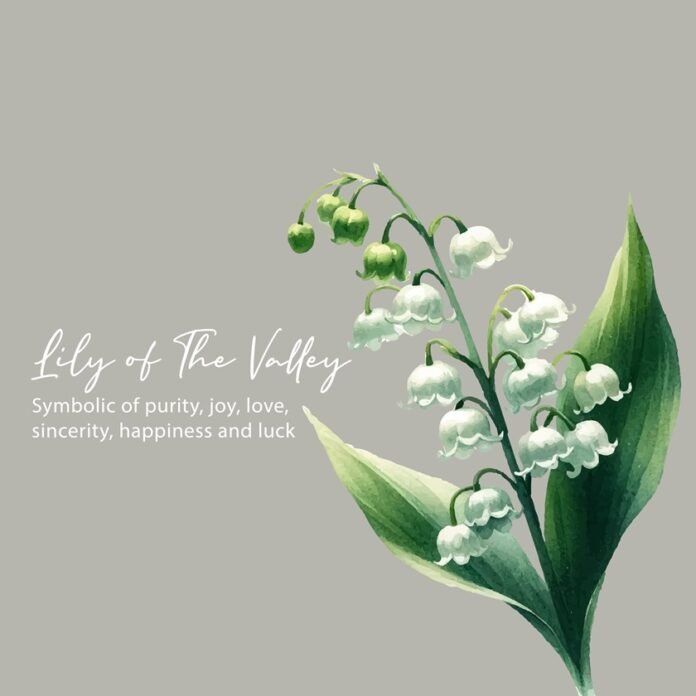Lily of the Valley (scientific name Convallaria majalis) is a perennial flowering plant known for its sweetly scented, bell-shaped white flowers. Here are some key details about Lily of the Valley:
Meaning and Symbolism of Lily of the Valley:
Lily of the Valley holds deep meaning and symbolism across various cultures and traditions. Here are some of the key symbolic meanings associated with this delicate and fragrant flower:
Symbolism
Purity and Humility:
- The pristine white flowers symbolize purity and modesty.
- Often associated with the Virgin Mary in Christian symbolism, representing purity and the return of happiness.
Happiness and Joy:
- The plant is often linked to the return of happiness, particularly in spring when it blooms.
- In France, it is traditionally given as a token of good luck and happiness on May 1st, known as La Fête du Muguet (Lily of the Valley Day).
Sweetness and Motherhood:
- The sweet fragrance and delicate appearance make it a symbol of the sweetness and gentleness of motherhood.
- Sometimes included in bridal bouquets to convey the purity of the bride and the sweetness of new beginnings.
Renewal and Rebirth:
- As a spring flower, it represents renewal and the promise of new life after the winter.
- In many cultures, it is associated with the themes of rebirth and the cyclical nature of life.
Cultural Significance
Christian Symbolism:
- Known as “Our Lady’s Tears” in Christian tradition, it is said to have sprung from the tears of the Virgin Mary at the crucifixion of Jesus.
- Represents the sorrow and tears of Mary, eventually leading to the joy of resurrection.
French Tradition:
- In France, Lily of the Valley is a symbol of good luck and is celebrated on May 1st, when people give bouquets of the flower to friends and family.
- This tradition dates back to 1561 when King Charles IX received a lily of the valley as a lucky charm and decided to offer it to the ladies of his court each year.
Weddings and Anniversaries:
- Frequently included in wedding bouquets and arrangements due to its connotations of purity and joy.
- It is also the flower for the 2nd wedding anniversary, symbolizing the renewal of love and commitment.
Victorian Language of Flowers:
- In the Victorian era, flowers were used to convey messages and emotions. Lily of the Valley symbolized the return of happiness.
- It could be used to express the joy of seeing someone again or the happiness they bring.
Literary and Artistic References
- Lily of the Valley often appears in literature and art as a symbol of beauty, purity, and renewal.
- It has been featured in works by poets and artists who emphasize its delicate beauty and deep symbolic meanings.
Modern Usage
- Today, it remains a popular flower for gardens, bouquets, and perfumes.
- Its enduring symbolism makes it a timeless choice for expressing sentiments of purity, happiness, and renewal.
Cultural Significance in Folklore and Literature:
Lily of the Valley has a rich presence in folklore and literature, often imbued with deep cultural significance. Here are some notable examples:
Folklore
European Folklore:
- In various European cultures, Lily of the Valley is associated with fairies. It is believed that the tiny bell-shaped flowers provide a place for the fairies to sleep and shelter.
- The flowers are thought to protect gardens from evil spirits and bring luck to those who cultivate them.
French Tradition:
As mentioned earlier, in France, Lily of the Valley is given on May 1st, known as La Fête du Muguet, as a symbol of good luck and happiness. This tradition is said to date back to the Renaissance when King Charles IX received a bouquet as a lucky charm.
English Folklore:
In England, it is said that the flower symbolizes the return of happiness. It is believed that the flower can help purify the heart and bring peace and calm.
German Folklore:
According to German folklore, the flowers sprang from the blood of St. Leonard during his battle with a dragon, symbolizing purity and the triumph of good over evil.
Literature
Biblical References:
While not explicitly mentioned in the Bible, Lily of the Valley is often used in Christian literature as a symbol of Christ and the Virgin Mary, representing purity, humility, and the return of joy.
Medieval and Renaissance Literature:
- In medieval times, Lily of the Valley was a symbol of chastity and humility and frequently appeared in religious texts and illuminated manuscripts.
- Renaissance poets often included Lily of the Valley in their works to evoke themes of beauty and renewal.
Modern Literature:
- Henry David Thoreau: In his journals, Thoreau mentions Lily of the Valley as a symbol of the arrival of spring and the renewal of nature.
- Edith Wharton: In her novel “The House of Mirth,” Wharton uses Lily of the Valley to symbolize purity and innocence in the character of Lily Bart, juxtaposing her inner qualities with her societal challenges.
- Vladimir Nabokov: In “Ada, or Ardor: A Family Chronicle,” Nabokov frequently references Lily of the Valley, associating it with themes of memory, nostalgia, and the passage of time.
Poetry:
- William Wordsworth: In his poetry, Wordsworth often celebrated the beauty of nature, and flowers like Lily of the Valley featured prominently as symbols of purity and the sublime.
- Emily Dickinson: Known for her nature-inspired poetry, Dickinson used Lily of the Valley to convey messages of hope, renewal, and the delicate balance of life.
Mythological References
Roman Mythology:
According to Roman legend, Lily of the Valley was created by the goddess Flora. She transformed the droplets of the hunter Orion’s sweat into the flowers as he pursued the Pleiades.
Celtic Mythology:
In Celtic lore, the plant is associated with the faerie world, often linked to the otherworldly beauty and purity of the fae.
FAQs:
Lily of the valley is cherished for its delicate, bell-shaped flowers and enchanting fragrance, often symbolizing purity and renewal. Its scent has made it a beloved ingredient in perfumery, and its aesthetic appeal makes it a popular choice in gardens and floral arrangements.
While it is generally safe to touch lily of the valley, it is important to wash your hands afterward as all parts of the plant are toxic if ingested. Care should be taken, especially around children and pets.
Lily of the valley is both good and bad; its fragrance and beauty offer significant aesthetic and aromatherapy benefits, but the plant itself is toxic and can cause serious health issues if ingested. Handling it with care and ensuring it is kept out of reach of children and pets is essential.
Lily of the valley symbolizes purity, humility, and a return to happiness. It is often associated with renewal and the arrival of spring.
Lily of the valley is known for its delicate, white, bell-shaped flowers and its sweet, fresh fragrance. It is also renowned for its toxic properties and its symbolic meanings in various cultures and traditions.
In mythology, lily of the valley is often linked to stories of love and purity. One popular legend is that the flowers sprang from the tears of the Virgin Mary at the crucifixion of Jesus, symbolizing sorrow and purity.
In the Bible, the lily of the valley is often interpreted as a symbol of Christ’s purity, humility, and the promise of hope and renewal. It represents the beauty and simplicity of faith.








